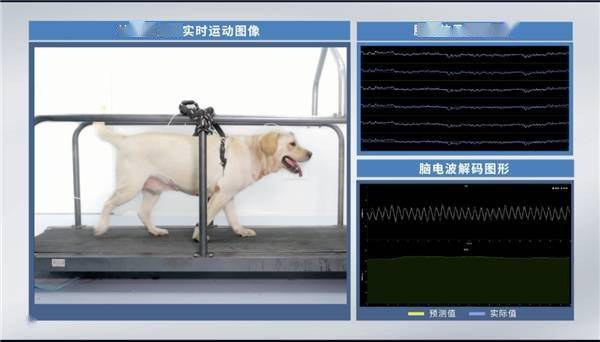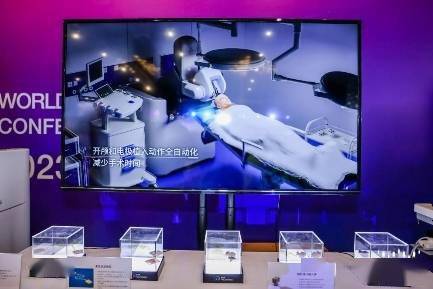 Technology peripherals
Technology peripherals
 AI
AI
 Brain Tiger Technology: Running at the forefront of 'brain-computer interface' and achieving phased results in cross-border integration
Brain Tiger Technology: Running at the forefront of 'brain-computer interface' and achieving phased results in cross-border integration
Brain Tiger Technology: Running at the forefront of 'brain-computer interface' and achieving phased results in cross-border integration
At the just-concluded World Artificial Intelligence Conference, the theme of brain-inspired intelligence and brain-computer interface has become one of the frontier directions of focus. Combining biotechnology and information technology (BTIT), brain-computer interface has become a new role in the era of cross-border integration. It is a connection channel between biological nervous system and digital system, and it is an emerging and disruptive technology field.
After more than two years of development, Brain Tiger Technology released seven scientific research results on the forum, introducing recent exploration and results from three dimensions: flexible electrodes, animal experiments, and exploratory human experiments. The animal employee experiments of Brain Tiger Technology aroused great interest from the audience, especially the 2-year-old Labrador "Neo" and the 7-year-old rhesus monkey "Wukong". After brain-computer interface electrode implantation surgery, they were successfully implanted with 256-channel cortical electrodes and were able to collect LFP signals.

In May of this year, we conducted an experiment and implanted a semi-invasive brain-computer interface device into rhesus monkeys, successfully allowing them to participate in and complete the ping pong game. Peng Lei, co-founder and CEO of Brain Tiger Technology, said that the brain-computer interface was implanted in rhesus monkeys for game playing experiments. In terms of decoding accuracy, the correlation between the predicted trajectory and the real trajectory was more than 85%, and the delay was controlled within 30ms. , while achieving stable decoding for more than 14 days. By laying a solid scientific research foundation for future brain control experiments, we have taken the first step towards clinical experiments.
China’s “brain-computer road” requires a long and hard work before it has a long way to go
This year is a special year, because it has been 50 years since we first proposed the concept of brain-computer interface. It was first proposed by American scientists in 1973. In China, brain-computer interface has developed for 20 years and has become the core technology and breakthrough focus of the industry.
President Ming Dong, Vice President of Tianjin University, said at the forum, "We have spent 20 years catching up with the Americans on the road that they have gone through for 50 years, and this process is inseparable from everyone's joint efforts. Brain-computer interface is a game-changer. An important disruptive technology that can change our human life, production and even the bottom layer, the future of brain-computer interface is worthy of all our expectations. However, today's brain-computer interface is still in its infancy and faces huge challenges and a long road. .”
Tao Hu, deputy director of the Shanghai Institute of Microsystems, Chinese Academy of Sciences and founder of Brainhu Technology, is also the responsible expert in the field of simulated brain for the "China Brain Project" and has led the team to launch a unique flexible brain-computer interface technology based on silk protein. , Compared with the implantable solutions of other teams, this flexible technology has more advantages in terms of the trauma of the surgery itself and the long-term safety and stability of the body after implantation. The next step in the development of brain-computer interfaces is to increase bandwidth and precision, which means that more neurons can be recorded simultaneously and the quality of the signals can be improved.
Tao Hu believes that the brain is like a supercomputer. On the one hand, it is powerful and has more than 80 billion neurons. Each of them can interact with hundreds or thousands of surrounding neurons to form a powerful network. On the other hand, this "supercomputer" consumes very little energy, averaging less than 30 watts. While top-level supercomputers designed according to the von Neumann architecture have extremely powerful computing power, their power consumption is worth several Thousands of households.

To make computers have the capabilities and "performance-to-power ratio" of the human brain, there are currently two possible paths: one is to develop brain-like chips and brain-like computing architecture through brain-inspired research to simulate brain operation; the other is to Interact with the human brain with the help of brain-computer interface, skip the facial features and limbs, and directly utilize the core capabilities of the brain.
Tao Hu believes that brain-computer interface is the process of turning patients back into normal people, which means more clinical research and greater diagnosis and treatment of major brain diseases. The ceiling of brain-computer interface is to turn normal people into supermen. It is hoped that through brain-computer interface, our brains can be combined with more powerful sensors and actuators from the outside world, so that our five senses and limbs can be extended more.
The above is the detailed content of Brain Tiger Technology: Running at the forefront of 'brain-computer interface' and achieving phased results in cross-border integration. For more information, please follow other related articles on the PHP Chinese website!

Hot AI Tools

Undresser.AI Undress
AI-powered app for creating realistic nude photos

AI Clothes Remover
Online AI tool for removing clothes from photos.

Undress AI Tool
Undress images for free

Clothoff.io
AI clothes remover

Video Face Swap
Swap faces in any video effortlessly with our completely free AI face swap tool!

Hot Article

Hot Tools

Notepad++7.3.1
Easy-to-use and free code editor

SublimeText3 Chinese version
Chinese version, very easy to use

Zend Studio 13.0.1
Powerful PHP integrated development environment

Dreamweaver CS6
Visual web development tools

SublimeText3 Mac version
God-level code editing software (SublimeText3)

Hot Topics
 1386
1386
 52
52
 I Tried Vibe Coding with Cursor AI and It's Amazing!
Mar 20, 2025 pm 03:34 PM
I Tried Vibe Coding with Cursor AI and It's Amazing!
Mar 20, 2025 pm 03:34 PM
Vibe coding is reshaping the world of software development by letting us create applications using natural language instead of endless lines of code. Inspired by visionaries like Andrej Karpathy, this innovative approach lets dev
 Top 5 GenAI Launches of February 2025: GPT-4.5, Grok-3 & More!
Mar 22, 2025 am 10:58 AM
Top 5 GenAI Launches of February 2025: GPT-4.5, Grok-3 & More!
Mar 22, 2025 am 10:58 AM
February 2025 has been yet another game-changing month for generative AI, bringing us some of the most anticipated model upgrades and groundbreaking new features. From xAI’s Grok 3 and Anthropic’s Claude 3.7 Sonnet, to OpenAI’s G
 How to Use YOLO v12 for Object Detection?
Mar 22, 2025 am 11:07 AM
How to Use YOLO v12 for Object Detection?
Mar 22, 2025 am 11:07 AM
YOLO (You Only Look Once) has been a leading real-time object detection framework, with each iteration improving upon the previous versions. The latest version YOLO v12 introduces advancements that significantly enhance accuracy
 Best AI Art Generators (Free & Paid) for Creative Projects
Apr 02, 2025 pm 06:10 PM
Best AI Art Generators (Free & Paid) for Creative Projects
Apr 02, 2025 pm 06:10 PM
The article reviews top AI art generators, discussing their features, suitability for creative projects, and value. It highlights Midjourney as the best value for professionals and recommends DALL-E 2 for high-quality, customizable art.
 Is ChatGPT 4 O available?
Mar 28, 2025 pm 05:29 PM
Is ChatGPT 4 O available?
Mar 28, 2025 pm 05:29 PM
ChatGPT 4 is currently available and widely used, demonstrating significant improvements in understanding context and generating coherent responses compared to its predecessors like ChatGPT 3.5. Future developments may include more personalized interactions and real-time data processing capabilities, further enhancing its potential for various applications.
 Best AI Chatbots Compared (ChatGPT, Gemini, Claude & More)
Apr 02, 2025 pm 06:09 PM
Best AI Chatbots Compared (ChatGPT, Gemini, Claude & More)
Apr 02, 2025 pm 06:09 PM
The article compares top AI chatbots like ChatGPT, Gemini, and Claude, focusing on their unique features, customization options, and performance in natural language processing and reliability.
 How to Use Mistral OCR for Your Next RAG Model
Mar 21, 2025 am 11:11 AM
How to Use Mistral OCR for Your Next RAG Model
Mar 21, 2025 am 11:11 AM
Mistral OCR: Revolutionizing Retrieval-Augmented Generation with Multimodal Document Understanding Retrieval-Augmented Generation (RAG) systems have significantly advanced AI capabilities, enabling access to vast data stores for more informed respons
 Top AI Writing Assistants to Boost Your Content Creation
Apr 02, 2025 pm 06:11 PM
Top AI Writing Assistants to Boost Your Content Creation
Apr 02, 2025 pm 06:11 PM
The article discusses top AI writing assistants like Grammarly, Jasper, Copy.ai, Writesonic, and Rytr, focusing on their unique features for content creation. It argues that Jasper excels in SEO optimization, while AI tools help maintain tone consist



